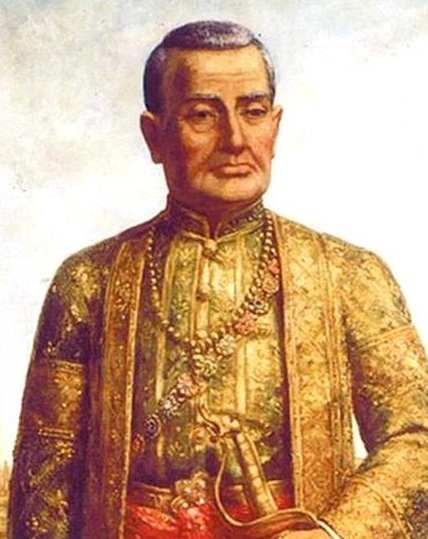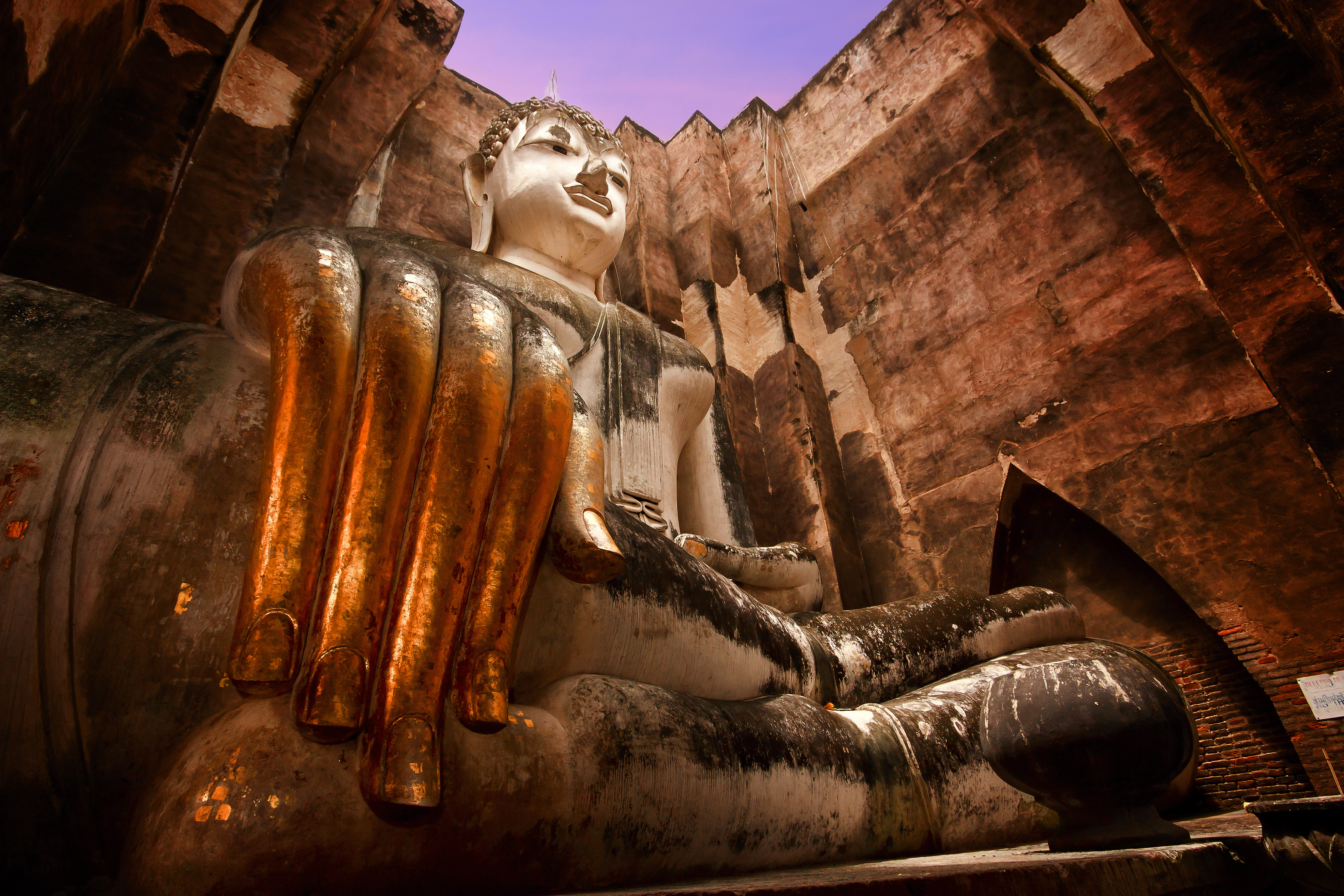|
Wat Phra Kaew
Wat Phra Kaew ( th, аё§аёұаё”аёһаёЈаё°а№ҒаёҒа№үаё§, , ), commonly known in English as the Temple of the Emerald Buddha and officially as Wat Phra Si Rattana Satsadaram, is regarded as the most sacred Buddhist temple in Thailand. The complex consists of a number of buildings within the precincts of the Grand Palace in the historical centre of Bangkok. It houses the statue of the Emerald Buddha, which is venerated as the country's palladium. Construction of the temple began in 1783 under the orders of Rama I, the first king of the Chakri dynasty. Since then, each successive king has been personally involved in adding, restoring and embellishing the temple during their reigns as a way of making religious merit and glorifying the dynasty. Many important state and royal ceremonies are held within the temple each year, presided by the king in person and attended by government officials. This makes the temple the nation's preeminent place of worship and a national shrine for the m ... [...More Info...] [...Related Items...] OR: [Wikipedia] [Google] [Baidu] |
Theravada
''TheravДҒda'' () ( si, ථа·ҡරа·Җа·Ҹа¶Ҝа¶ә, my, бҖ‘бҖұбҖӣбҖқбҖ«бҖ’, th, а№Җаё–аёЈаё§аёІаё—, km, бһҗбҹҒбһҡбһңбһ¶бһ‘, lo, а»Җаә–аәЈаә°аә§аәІаә”, pi, , ) is the most commonly accepted name of Buddhism's oldest existing school. The school's adherents, termed TheravДҒdins, have preserved their version of Gautama Buddha's teaching or ''Buddha Dhamma'' in the PДҒli Canon for over two millennia. The PДҒli Canon is the most complete Buddhist canon surviving in a classical Indian language, PДҒli, which serves as the school's sacred language and ''lingua franca''.Crosby, Kate (2013), ''Theravada Buddhism: Continuity, Diversity, and Identity'', p. 2. In contrast to '' MahДҒyДҒna'' and '' VajrayДҒna'', TheravДҒda tends to be conservative in matters of doctrine ('' pariyatti'') and monastic discipline (''vinaya''). One element of this conservatism is the fact that TheravДҒda rejects the authenticity of the Mahayana sutras (which appeared c. 1st century BCE onwards). Modern Ther ... [...More Info...] [...Related Items...] OR: [Wikipedia] [Google] [Baidu] |
Taksin
King Taksin the Great ( th, аёӘаёЎа№Җаё”а№ҮаёҲаёһаёЈаё°а№ҖаёҲа№үаёІаё•аёІаёҒаёӘаёҙаёҷаёЎаё«аёІаёЈаёІаёҠ, , ) or the King of Thonburi ( th, аёӘаёЎа№Җаё”а№ҮаёҲаёһаёЈаё°а№ҖаёҲа№үаёІаёҒаёЈаёёаёҮаёҳаёҷаёҡаёёаёЈаёө, ; ; Teochew: DГӘn Chao; April 17, 1734 вҖ“ April 7, 1782) was the only king of the Thonburi Kingdom. He had been an aristocrat in the Ayutthaya Kingdom and then was a major leader during the liberation of Siam from Burmese occupation after the Second Fall of Ayutthaya in 1767, and the subsequent unification of Siam after it fell under various warlords. He established the city of Thonburi as the new capital, as the city of Ayutthaya had been almost completely destroyed by the invaders. His reign was characterized by numerous wars; he fought to repel new Burmese invasions and to subjugate the northern Thai kingdom of Lanna, the Laotian principalities, and a threatening Cambodia. Although warfare occupied most of Taksin's reign, he paid a great deal of attention to politic ... [...More Info...] [...Related Items...] OR: [Wikipedia] [Google] [Baidu] |
Ayutthaya Historical Park
Ayutthaya Historical Park ( th, аёӯаёёаё—аёўаёІаёҷаёӣаёЈаё°аё§аёұаё•аёҙаёЁаёІаёӘаё•аёЈа№ҢаёһаёЈаё°аёҷаё„аёЈаёЁаёЈаёөаёӯаёўаёёаёҳаёўаёІPronunciation) covers the ruins of the old city of Ayutthaya, Phra Nakhon Si Ayutthaya Province, Thailand. The city of Ayutthaya was founded by King Ramathibodi I in 1351, though it is likely to be significantly older, based on evidence showing that the area was already populated during the Mon Dvaravati period. Sources further mention that around 850 AD, the Khmers occupied the area and established a stronghold there, naming it Ayodhya, after one of the holiest Hindu cities in India of the same name. The early history of Ayutthaya is connected to this Khmer settlement. Additionally, Prince Damrong has also attested to the existence of a city named Ayodhya, founded by the Khmers ruling from Lopburi at the point where the three rivers meet. An excavation map shows traces of an ancient baray (water reservoir) close to the southwestern tip of Wat ... [...More Info...] [...Related Items...] OR: [Wikipedia] [Google] [Baidu] |
Wat Phra Si Sanphet
Wat Phra Si Sanphet ( th, аё§аёұаё”аёһаёЈаё°аёЁаёЈаёөаёӘаёЈаёЈа№ҖаёһаёҠаёҚа№Ң; "Temple of the Holy, Splendid Omniscient") was the holiest temple on the site of the old Royal Palace in Thailand's ancient capital of Ayutthaya until the city was completely destroyed by the Burmese in 1767. It was the grandest and most beautiful temple in the capital and it served as a model for Wat Phra Kaew in Bangkok. History In 1350 U-thong, also known as King Ramathibodi I, ordered the construction of a royal palace in the same area that Wat Pra Si Sanphet stands today. The palace was completed in 1351 and King Ramathibodi established Ayutthaya as the capital of his Kingdom. The palace contained three wooden buildings named "Phaithun Maha Prasat", "Phaichayon Maha Prasat", and "Aisawan Maha Prasat". Upon finalization of the palace in 1351, he established Ayutthaya as his capital and was bestowed the title of King Ramathibodi I. In 1448 King Borommatrailokkanat built a new palace to the north an ... [...More Info...] [...Related Items...] OR: [Wikipedia] [Google] [Baidu] |
Sukhothai Historical Park
Sukhothai Historical Park ( th, аёӯаёёаё—аёўаёІаёҷаёӣаёЈаё°аё§аёұаё•аёҙаёЁаёІаёӘаё•аёЈа№ҢаёӘаёёа№ӮаёӮаё—аёұаёўPronunciation) covers the ruins of Sukhothai, literally 'dawn of happiness', capital of the Sukhothai Kingdom in the 13th and 14th centuries, in north central Thailand. It is near the city of Sukhothai, capital of Sukhothai Province. The city's walls form a rectangle about east-west by north-south. There are 193 ruins on of land. There is a gate in the centre of each wall. Inside are the remains of the royal palace and twenty-six temples, the largest being Wat Mahathat. The park is maintained by the Fine Arts Department of Thailand with help from UNESCO, which has declared it a World Heritage Site. Each year, the park welcomes thousands of visitors. History Khmer Era Originally, Sukhothai was a Khmer empire's outpost named ''Sukhodaya''. During the reign of Khmer Empire, the Khmers built some monuments there, several of them survived in Sukhothai Historical ... [...More Info...] [...Related Items...] OR: [Wikipedia] [Google] [Baidu] |
Bhikkhu
A ''bhikkhu'' (Pali: аӨӯаӨҝаӨ•аҘҚаӨ–аҘҒ, Sanskrit: аӨӯаӨҝаӨ•аҘҚаӨ·аҘҒ, ''bhikб№Јu'') is an ordained male in Buddhist monasticism. Male and female monastics (" nun", '' bhikkhunД«'', Sanskrit ''bhikб№Јuб№ҮД«'') are members of the Sangha (Buddhist community). The lives of all Buddhist monastics are governed by a set of rules called the prДҒtimokб№Јa or pДҒtimokkha. Their lifestyles are shaped to support their spiritual practice: to live a simple and meditative life and attain nirvana. A person under the age of 20 cannot be ordained as a bhikkhu or bhikkhuni but can be ordained as a ЕӣrДҒmaб№Үera or ЕӣrДҒmaб№ҮД“rД«. Definition ''Bhikkhu'' literally means " beggar" or "one who lives by alms". The historical Buddha, Prince Siddhartha, having abandoned a life of pleasure and status, lived as an alms mendicant as part of his Еӣramaб№Үa lifestyle. Those of his more serious students who renounced their lives as householders and came to study full-time under his supervision als ... [...More Info...] [...Related Items...] OR: [Wikipedia] [Google] [Baidu] |
Buddhist Monasticism
Buddhist monasticism is one of the earliest surviving forms of organized monasticism and one of the fundamental institutions of Buddhism. Monks and nuns, called bhikkhu ( Pali, Skt. bhikshu) and bhikkhuni (Skt. bhikshuni), are responsible for the preservation and dissemination of the Buddha's teaching and the guidance of Buddhist lay people. Three surviving traditions of monastic discipline (Vinaya), govern modern monastic life in different regional traditions: Theravada (Sri Lanka and Southeast Asia), Dharmaguptaka (East Asia), and Mulasarvastivada (Tibet and the Himalayan region). History and development Buddhism originated as a renunciant tradition, practiced by ascetics who had departed from lay life. According to Buddhist tradition, the order of monks and nuns was founded by Gautama Buddha during his lifetime between the fifth and fourth centuries BCE when he accepted a group of fellow renunciants as his followers. The Buddhist monastic lifestyle grew out of the ... [...More Info...] [...Related Items...] OR: [Wikipedia] [Google] [Baidu] |
Buddhist Temple
A Buddhist temple or Buddhist monastery is the place of worship for Buddhists, the followers of Buddhism. They include the structures called vihara, chaitya, stupa, wat and pagoda in different regions and languages. Temples in Buddhism represent the pure land or pure environment of a Buddha. Traditional Buddhist temples are designed to inspire inner and outer peace. Architecture Its architecture and structure varies from region to region. Usually, the temple consists not only of its buildings, but also the surrounding environment. The Buddhist temples are designed to symbolize five elements: fire, air, water, earth and wisdom. India The design of temples in India was influenced by the idea of a place of worship as a representation of the universe. For Buddhist temple complexes one tall temple is often centrally located and surrounded by smaller temples and walls. This center surrounded by oceans, lesser mountains and a huge wall. A Chaitya, Chaitya hall or Chaitya-g ... [...More Info...] [...Related Items...] OR: [Wikipedia] [Google] [Baidu] |
Rattanakosin Island
Rattanakosin Island ( th, а№ҖаёҒаёІаё°аёЈаёұаё•аёҷа№ӮаёҒаёӘаёҙаёҷаё—аёЈа№Ң, , ) is a historic area in the Phra Nakhon District in the city of Bangkok, Thailand. It is bordered by the Chao Phraya River to the west and various canals to the east that were dug to serve as moats for what was originally the fortified city center. Situated on the eastern convex bank of a meander in the Chao Phraya River, the island is the site of the Grand Palace and Bangkok's City Pillar Shrine, among other places of historical significance. History King Phutthayotfa Chulalok (Rama I) founded the city as the capital of his new Rattanakosin Kingdom in 1782. Before Bangkok became the capital of Thailand, the capital city was Thonburi __NOTOC__ Thonburi ( th, аёҳаёҷаёҡаёёаёЈаёө) is an area of modern Bangkok. During the era of the Kingdom of Ayutthaya, its location on the right (west) bank at the mouth of the Chao Phraya River had made it an important garrison town, which .... The old city ... [...More Info...] [...Related Items...] OR: [Wikipedia] [Google] [Baidu] |
Chao Phraya River
The Chao Phraya ( or ; th, а№ҒаёЎа№Ҳаёҷа№үаёіа№ҖаёҲа№үаёІаёһаёЈаё°аёўаёІ, , or ) is the major river in Thailand, with its low alluvial plain forming the centre of the country. It flows through Bangkok and then into the Gulf of Thailand. Etymology On many old European maps, the river is named the ''Mae Nam'' (Thai: а№ҒаёЎа№Ҳаёҷа№үаёі), the Thai word for "river" (literally, "motherly water"). James McCarthy, F.R.G.S., who served as Director-General of the Siamese Government Surveys prior to establishment of the Royal Survey Department, wrote in his account, "''Mae Nam'' is a generic term, ''mae'' signifying "mother" and ''Nam'' "water," and the epithet Chao P'ia signifies that it is the chief river in the kingdom of Siam." H. Warington Smyth, who served as Director of the Department of Mines in Siam from 1891 to 1896, refers to it in his book first published in 1898 as "the Mae Nam Chao Phraya". In the English-language media in Thailand, the name Chao Phraya River is of ... [...More Info...] [...Related Items...] OR: [Wikipedia] [Google] [Baidu] |
Wat Molilokkayaram
Wat Molilokkayaram Ratchawarawihan or simply Wat Molilokkayaram ( th, аё§аёұаё”а№ӮаёЎаёҘаёөа№ӮаёҘаёҒаёўаёІаёЈаёІаёЎ аёЈаёІаёҠаё§аёЈаё§аёҙаё«аёІаёЈ, аё§аёұаё”а№ӮаёЎаёҘаёөа№ӮаёҘаёҒаёўаёІаёЈаёІаёЎ) is an ancient Thai temple site between Wat Arun and Wat Kalayanamitr rim Khlong Bangkok Yai near Anuthin Sawat Bridge and close to Tonson Mosque. History The temple is a second class royal monastery, it was built in mid-18th century (around end of Ayutthaya period) without knowing who founded, in that era it was named "Wat Tai Talat" (аё§аёұаё”аё—а№үаёІаёўаё•аёҘаёІаё”; lit: "Temple at market tip") because it is located in the area next to the end of Thonburi Market. Up until now this name is still used as an informal name for the temple. In 1767, King Taksin incorporated the temple as part of his Thonburi Palace. Later, in Rattanakosin period, King Phutthaloetla Naphalai (Rama ll) renovated the ordination hall and renamed "Wat Phutthaisawan" (аё§аёұаё”аёһุทไаёҳаёӘаё§аёЈаёЈаё„а№ ... [...More Info...] [...Related Items...] OR: [Wikipedia] [Google] [Baidu] |



%2C_Ayutthaya%2C_Thailand.jpg)




_-_img_05.jpg)